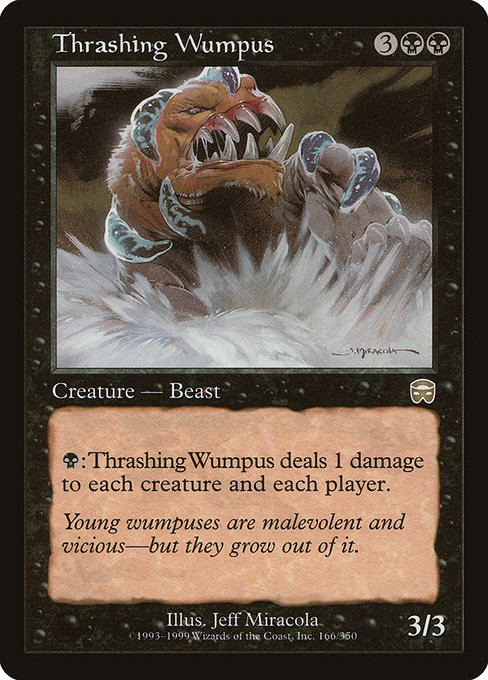
Image courtesy of Scryfall.com
A Black Beast Through Time: Thrashing Wumpus and Its Set-by-Set Journey
When Mercadian Masques burst onto the scene in 1999, it carried with it a wave of design ideas that would ripple through MTG for years. Thrashing Wumpus arrived as a rare, a rarity that often signals a card worth a second look long after it leaves the standard-legal metagame. With a mana cost of {3}{B}{B}, this 3/3 Beast asks a five-mana investment for a body that can—on a single tap—punish wide boards and nimble players alike. Its activated ability, "{B}: This creature deals 1 damage to each creature and each player," looks deceptively simple but creates a cascading set of decisions. Do you trade away your own board for a cleaner sweep, or hold back and threaten potential blowouts later in the game? 🧙♂️🔥
Language matters here: a black mana sink that threatens every creature and every player in play is exactly the kind of design that makes legacy and casual tables alike pause. Thrashing Wumpus wears its power lightly, but its implications run deep. The card is a rare from MMQ, a set that sits in the late 1990s era of MTG's evolution, when designers were experimenting with more mass-affect mechanics that could swing a game from a single activation. The creature’s 3/3 body gives you a solid midgame presence, and the ability to push a board toward a clearing can redefine how opponents plan their attacks and removals in the next turns. The flavor text—“Young wumpuses are malevolent and vicious—but they grow out of it”—gives the card a sense of mischief that fans still appreciate in retrospective discussions. The illustration by Jeff Miracola captures a wild, predatory feel that makes the card feel alive even when it’s not on the battlefield. 🎨
From a modern gameplay perspective, Thrashing Wumpus shines most when you’re playing a black-centric shell that can leverage value from slow or stalled boards. In multiplayer formats, its presence effectively acts as a soft reset button, punishing over-extensions and forcing opponents to adjust their tempo. In two-player duels, the decision to activate can be a dance of risk assessment: you clean the battlefield but accelerate the pace toward a race to the last few points of life. The card’s mana cost and body are a balanced trade-off—not so expensive that it sits in the binder, yet not so cheap that it breaks the tempo of a game. This is a classic example of MTG design that rewards patient play and careful timing, rather than raw inevitability. 🗺️
Looking longitudinally at its performance across sets and formats, Thrashing Wumpus stands as a marker of rarity-driven value rather than mass-market impact. It’s not part of Standard after its MMQ debut, and its era is firmly anchored in the pre-2000s ladder. Yet the card’s legal status in Legacy, Vintage, and Commander ensures that its life extends beyond a single issue of paper magic. The vintage- and legacy-focused communities appreciate it as a nostalgic piece that also offers practical play in certain black-centered archetypes. This durability across formats is a hallmark of cards that age gracefully—where playability and collectability converge. 🔎
Market dynamics around Thrashing Wumpus reflect its dual identity as both playable and collectible. The non-foil version sits at relatively modest prices in many marketplaces, while the foil version carries a premium that mirrors scarcity and visual appeal. In the data snapshot tied to its MMQ printing, the card shows a USD price around $0.82 for non-foil copies and a foil price near $37.15, with euro values offering a similar premium in foil form. Those figures aren’t just numbers; they reveal a long tail of demand driven by Legacy players who prize older rares for their robust, individual flavor and by collectors who chase the tactile thrill of a black-border rarity from the late 90s. This is one of those cards where nostalgia, rarity, and power in specific formats combine to sustain interest long after the initial print run. 💎
Artistically and mechanically, Thrashing Wumpus embodies a transitional moment in MTG design. It doesn’t rely on flashy mechanics; instead, it leverages a simple, brute-force effect that forces a strategic rethink about board state and life totals. The card’s feat—delivering one point of damage to every creature and every player—can be a turning point in a clutch moment, especially when a player tries to push through with a last-ditch assault. It’s a reminder that sometimes the most memorable plays spring from decisions you make with a single mana of black and a willingness to live with the consequences. ⚔️
For players who enjoy the historical arc of MTG, Thrashing Wumpus offers a tangible link between mercurial eras of the game. It sits at the crossroads of design boldness and collector appeal, a small but mighty piece of a broader story about how black mana has evolved to influence battlefield dynamics. And as modern players browse reprint histories, the MMQ print stands as a snapshot of a time when the game was expanding into new narrative and mechanical territory. 🧭
Whether you’re chasing a complete vintage binder, drafting in a Legacy night, or simply admiring the art and flavor, Thrashing Wumpus remains a vivid artifact from MTG’s late-1990s experimentation. It’s a card that confirms: sometimes the best stories in this hobby are measured not just by the number of cards you own, but by the memories you build around them.
Looking for a way to blend MTG lore with a practical purchase this week? Check out a product that blends style with utility for your everyday tech needs: Slim Glossy Phone Case for iPhone 16 — Durable Wireless Charge. 🧙♂️🔥
More from our network
- https://blog.digital-vault.xyz/blog/post/how-to-choose-the-right-niche-for-digital-downloads/
- https://blog.digital-vault.xyz/blog/post/how-to-create-tactile-illusions-on-digital-paper/
- https://blog.crypto-articles.xyz/blog/post/tracking-team-aquas-sealeo-usage-across-sets-a-tcg-analysis/
- https://blog.rusty-articles.xyz/blog/post/nanu-alternate-art-variants-fan-created-pokemon-tcg-art/
- https://blog.zero-static.xyz/blog/post/demonic-appetite-global-price-trends-for-mtg-collectors/